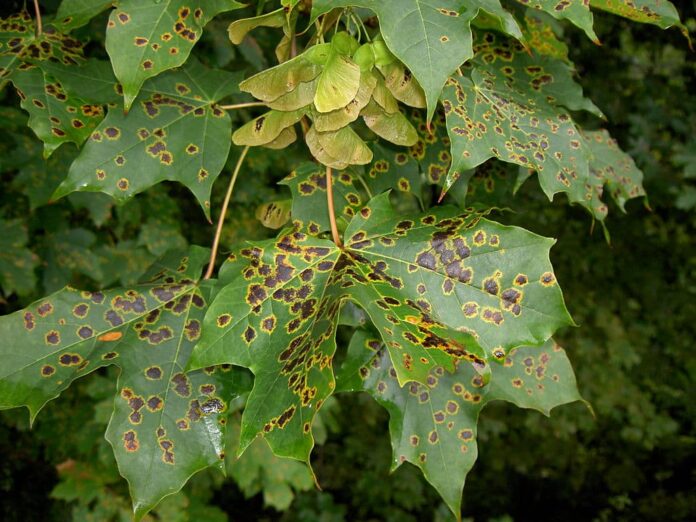Do you know that tree diseases and viruses exist? And do you know that some of the sick trees got the diseases because they were stressed? In fact, there are so many different viruses out there that infect not only trees but also plants. Even worse, some can also transmit those infections to other plants and trees nearby. The only good thing is that tree fungi and some tree diseases do not infect humans or animals. We are here to bring you some of the most common tree diseases that you will find in the list below. Let’s see if you have come across any of them, so check them out.
1Annosum Root Rot
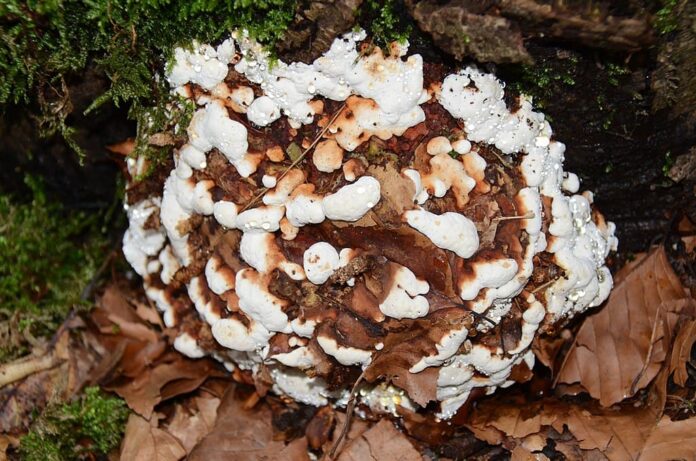
With a very wide host range, annosum root rot is a fungus that causes root decay as it weakens tree roots. This is one of the tree diseases that affect deep sandy soils or former agricultural land. The most common means that its spores can travel around is wind. Because the airborne spores enter the tree through a wound, loblolly, and slash pain are most severely affected. When that occurs, it grows through the heartwood into the roots which cause decay in the root system. Where there are root contacts, the fungus may also grow across and infect neighboring trees as well.
At the same time, it also leads to crown mortality, thinning, and yellowing with the chances of getting attacked by bark beetles. The infected roots show heavy resin leakage, and the weakened roots are at an increased risk of breakage and windthrow. Once the fungus infects entirely, the tree pockets are lost as the entire mass of wood becomes spongy or stringy. Even with the disease, the infected trees may survive for many years after the infection. To limit the fungal spread, you can treat the stumps with borax so that it will not further affect the trees.
2Anthracnose
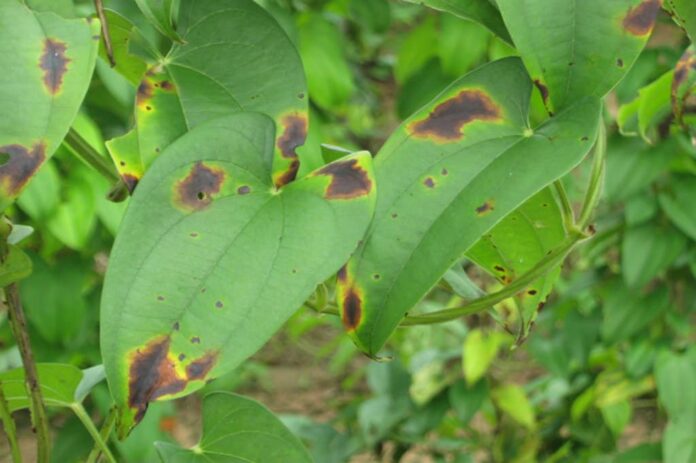
Many gardeners experience anthracnose, a fungal disease that affects a wide range of plants, trees, and shrubs mostly in spring. Along with that, it also sometimes grows on greenhouse crops, potted plants, tropical foliage plants, and woody ornamentals outdoors. The cool and rainy weather is favorable for its spores to spread on the leaves and twigs of the plants. It can survive on infected plant debris, and it can spread very easily and quickly. Once the dry and hot weather comes, the progression of the diseases will stop before it starts again in better conditions.
You can recognize anthracnose by the dark and sunken lesions with a number of small tan to brown dots. It usually occurs on the flowers, fruits, leaves, stems, and veins of the infected plants or trees. Although it is not fatal, this disease infects many deciduous and evergreen fruits, grass, shrubs, trees, and vegetables. You can prevent it from your greeneries by practicing good sanitation and proper pruning techniques. The main method to treat the plants is by providing proper fertilizer, light, and water to keep them healthy. This is to make them strong enough to ward off the fungus attack.
3Apple Scab
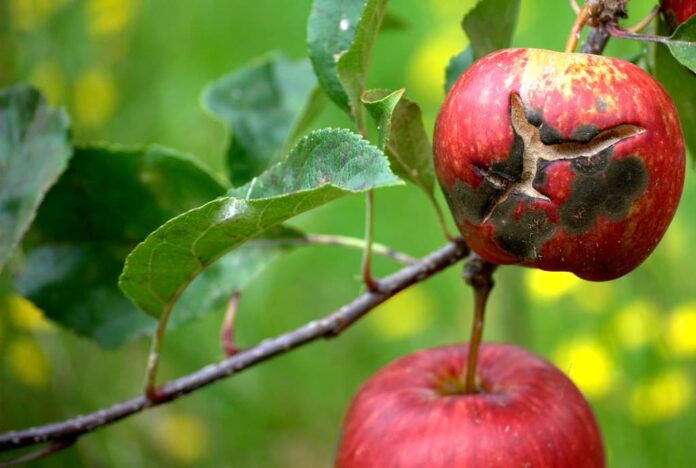
Just like the name suggests, it is a serious disease that affects apples. However, it does more than that since it also infects other plants such as firethorn, hawthorn, loquat, and more. This disease develops in cool and wet weather which is why it is very common in early summer and spring. The longer the leaves remain wet, the more severe the infection will be. Apple scab occurs everywhere in the world where there are apple trees, and it affects both the fruits and leaves. This fungal disease usually forms olive-green or pale-yellow spots on upper surfaces and dark velvety spots on the lower surfaces of the leaves. Those lesions often increase their size as a result of asexual spore production. The severely infected leaves become puckered and twisted then will drop from the trees in early summer.
As for fruits, the symptoms are similar with the sunken and tan scabby spots on them. Once the spores mature, they become larger while turning brown and corky. Along with that, there may be velvety spores in the center of the fruit as well. After the infection spreads completely, the fruit become distorted and drops before they ripen. Apple scab spreads by rain, wind, or splashing water from the ground to flowers, fruits, or leaves. To prevent it from spreading, you should destroy the infected leaves to reduce the number of fungal spores and rake under the trees. Make sure to inspect the apple trees so that you can identify the disease and take action immediately.
4Black Knot
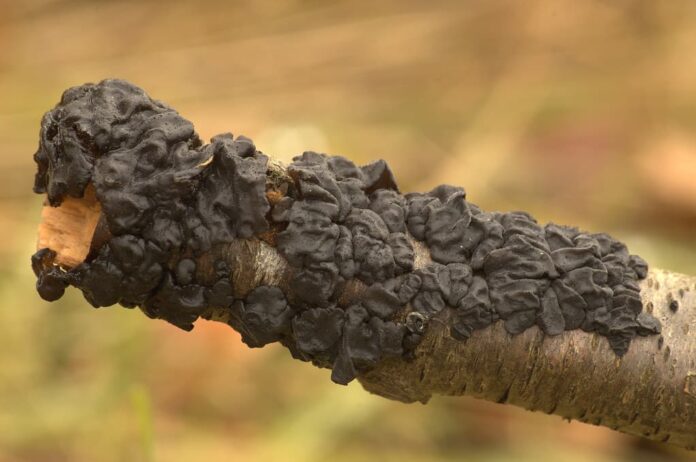
Black knot is a widespread fungal disease that attacks the fruiting and ornamental of cherry and plum trees. It is one of the dangerous tree diseases that develop slowly before becoming apparent and producing spores. The infection starts when the spores are released from established knots where the fungus overwinters. The spores germinate on stems beneath a thin film of moisture, often at the juncture of a new leaf start. Those spores travel to other parts of the tree, and they can travel to the nearby trees through breezes. You can notice this tree disease with its hard, uneven, and black galls that seem to enwrap the branches and twigs. This usually occurs during fall and winter, and you can see clearly since all the leaves have fallen.
The longer it grows, the strong it strangles the new growth and girdling branches of the trees. Without treatment, the tree will deteriorate or provide poor fruit production. Even worse, the galls also act as an entry for insects and other plant diseases to enter the trees. There are also tolerant trees that have many galls throughout them with few negative effects on their health. In case the trees are severely affected, their leaves and shoots will wilt and die on branches with galls. There are 3 main methods to manage black knots depending on the conditions of the trees. Those include pruning out galls, site and tree selection, and fungicides.
5Canker
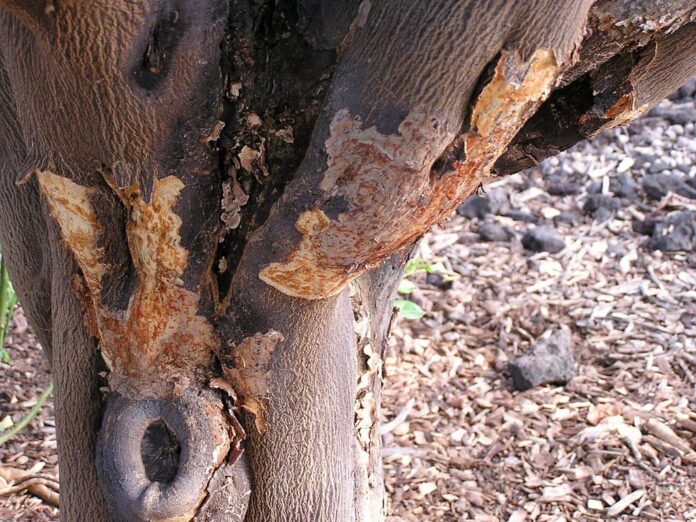
Canker disease, or canker in short, is one of the widespread tree diseases that infects a variety of shrubs and trees. The name of the disease actually tells the symptom of the trees that it infects. When infected, the tree will have blisters on its bark, branch, or trunk, usually with an oval shape. Sometimes it appears as depressed places or discolored areas on the bark of the tree. The fungus of this disease enters the tree and then grows between the bark and wood, killing those parts. There are several causes of cankers such as chemicals, environmental conditions, insects, lawnmowers, weed eaters, etc.
With canker, the trees are highly vulnerable to bacteria, fungi, and insects while being susceptible to wind damage. The healthier trees are more likely to ward off serious damages while young fruit trees have a difficult time recovering. This also indicates the method to prevent cankers because native tree species will suffer less stress. That means they can adapt well to the overall environmental conditions, soil type, and sun exposure in the area. To treat canker, the best way is to remove as many fungi as possible from the tree. You can also prune the tree in dry weather to prevent the infection and spread of the disease.
6Cedar Rust
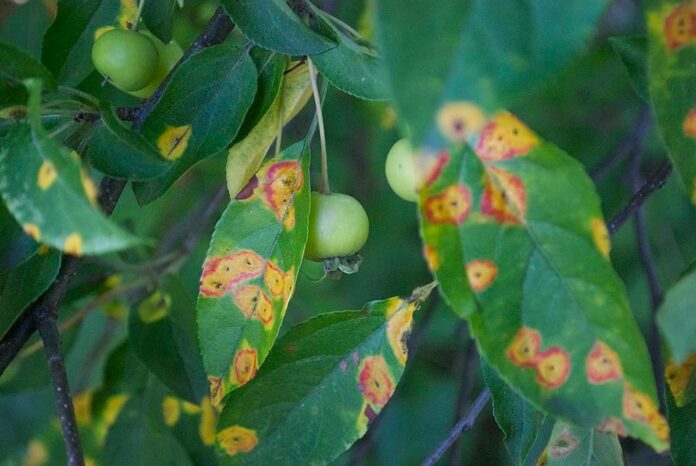
Probably the least dangerous among other tree diseases, cedar rust fungi will not kill their hosts. The thing is that even if the plants survive, the infections can seriously destroy and weaken the health of susceptible plants. In some worse cases, they will also lose their ornamental value because of the damages to the fruit and leaves. Cedar rust cannot be transferred from apple tree to apple tree or from juniper to juniper. The interesting thing about cedar rust is that it depends on two species to develop and spread. It begins when the pathogen’s spores develop as a reddish-brown gall on the juniper in late fall. As the spring showers begin, the galls grow and release spores that are carried by the wind to infect apple and crabapple trees.
The infected apple and crabapple trees manifest circular yellow spots on the upper surface of their leaves soon after bloom. Then brownish cylindrical tubes with hairs sticking out will appear on the fruit and twigs or underneath the yellow spots in summer. Once the infection damages the leaves, it affects the apple tree’s ability to gather nutrients and sunlight from the air. This will also lead to damage to fruit production and the overall health of the trees. You can easily prevent this disease by not planting eastern red cedar and juniper near plants and trees from the Rosaceae family. There are also a few methods to treat your trees such as biofungicide, fungicide liquid copper, etc.
7Leaf Blister
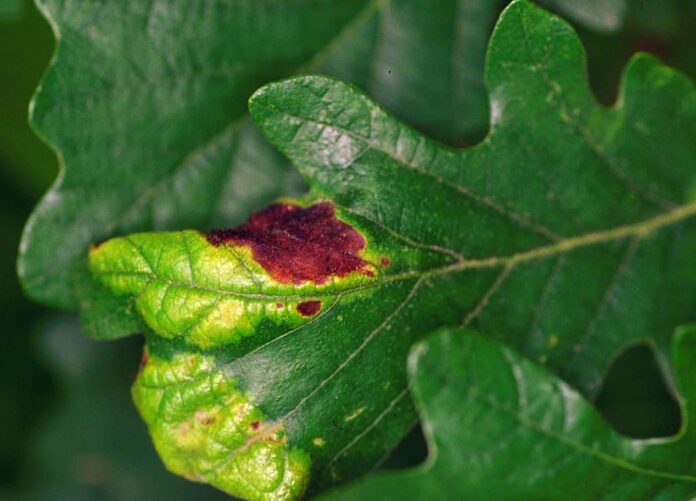
Definitely on the terrifying side, lead blister aka leaf curl is a worldwide disease that affects many ferns and woody plants. Because it often infects almonds, nectarines, and peaches, it often causes agricultural losses in the farms with those trees. When the infection starts, the leaves become crinkled, distorted, and swollen with blisters of various colors such as brown, red, etc. Then those leaves will die and drop early which weakens the entire plant when that occurs. You can also treat the infection if you spot it soon enough. Leaf blister is not lethal, and the management of this disease is by using chemical and cultural methods. So if you have susceptible plants, it is advisable to spray them every fall after the leaves have dropped.
8Lethal Yellow Of Palm
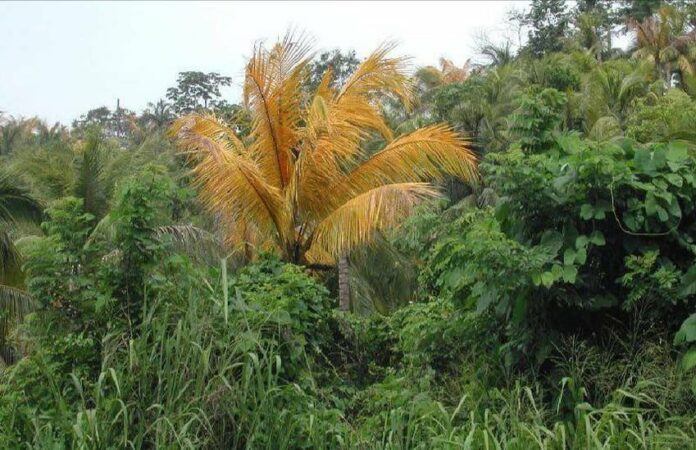
A lot of us have probably seen coconut trees or palm trees with yellow branches before. This color is a result of lethal yellowing which is a tropical disease that affects several palm tree species. It might not look serious, but it is a fatal disease that can devastate landscapes in areas that rely on palms. Planthoppers are insects that carry “phytoplasma” which is a microscopic organism that spreads this disease from tree to tree. The lethal yellow of palm appears in dry and humid temperatures because planthoppers can’t survive in below-freezing temperatures.
The symptoms of this disease show when both immature and mature coconuts begin to drop from the trees. Then the flower stalks start to blacken and palm fronds start to yellow begin it spreads to the crown. After that, the spear leaf collapses and the bud dies which also means the tree is already dead. The last stage is when the entire crown falls from the tree, leaving a forlorn “telephone pole” stalk. Without treatment, the tree will die completely within 3 to 6 months after the first symptom begins. There is a cure for this disease, the only way is to check so that you can spot the symptoms early.
9Oak Wilt
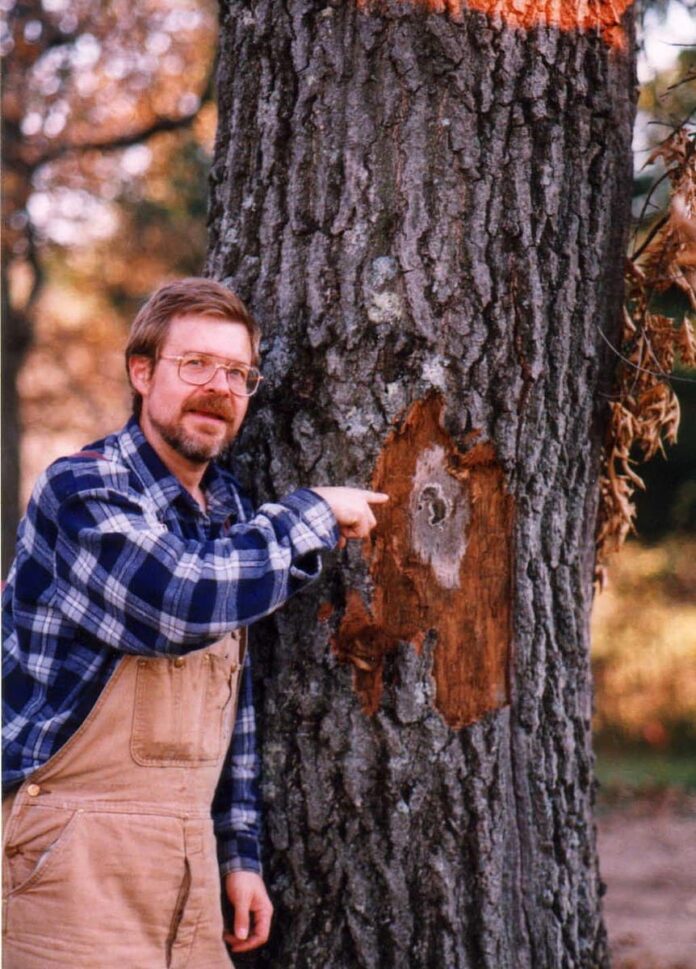
Oak wilt is a fungal disease that is extremely destructive and fatal for all oak species although some are more susceptible than others. Red oaks are very susceptible to the fungus while white oaks are more resistant so they rarely die from it. This disease causes increasing levels of mortality of oak trees all over the United States. Oak wilt spreads to other oak trees in 2 ways: grafted roots and long distances spread by beetles. The disease has the tendency to form root sprouts that result in a vast interconnected root system. This allows the infection to easily spread to adjacent trees, causing a serious impact on a large scale.
As for the long-distance spreading, sap-feeding beetles are believed to be responsible for it. These beetles are attracted to oak wilt fungal mats due to the sweet and fruity smell of the mats. Once they come to feed, the spores of the fungus will cling to their bodies. If a sap-feeding beetle with oak wilt spores lands on a fresh wound on a healthy oak, the tree can become infected. Oak wilt disables the water-conducting system in susceptible trees, and it is also an infectious vascular disease. It is one of the most dangerous tree diseases because it kills most of the oaks, and the treatment is expensive.
Oak Wilt Prevention
- Avoid pruning or wounding oaks between February and July because it is when the beetles are active.
- Sanitize or sterilize the pruning equipment with a general-purpose household disinfectant or isopropyl alcohol between trees using to prevent spreading.
- Immediately paint all wounds on oaks to prevent contact with the beetles, regardless of the time of the year.
- Promptly remove and either burn or bury all red oaks that are dying or recently died by oak wilt. This is to prevent the beetles from spreading the spores from the dead tree fungal mats to other trees nearby.
10Photinia Leaf Spot
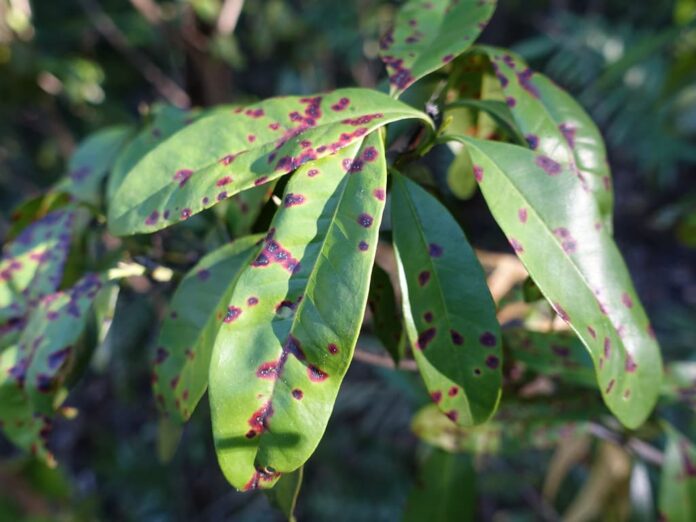
When the cool and wet weather conditions of spring and fall come, photinia leaf spot begins its infection. This fungal disease discolor and destroy the leaves of the plants, and it affects many different shrubs and trees. The disease appears when there is too much moisture, and it is rarely deadly. The infection begins with small black dots on leaves, then they grow and turn to a brownish-gray color with red outlines. It takes just a few weeks for the invisible black dots to become larger, and this symptom remains persistent throughout spring. When that happens, it results in a thin and frayed canopy followed by the premature leaf drop.
Once infected, the plants will need special care and maintenance to sustain their strength. You can do so by raking fallen leaves away and adding between 2 to 4 inches of layers of mulch in spring. When the weather is dry, water your plants thoroughly but make sure to not wet the foliage. As spring or fall rain subsides, you can prune and dispose of infected leaves to prevent the spread. Most importantly, never water your plants at night because it can lead to spores germination that infects the plants. In case you have a lot of plants, shrubs, and trees, specific fungicides for the disease are the method.
11Powdery Mildew
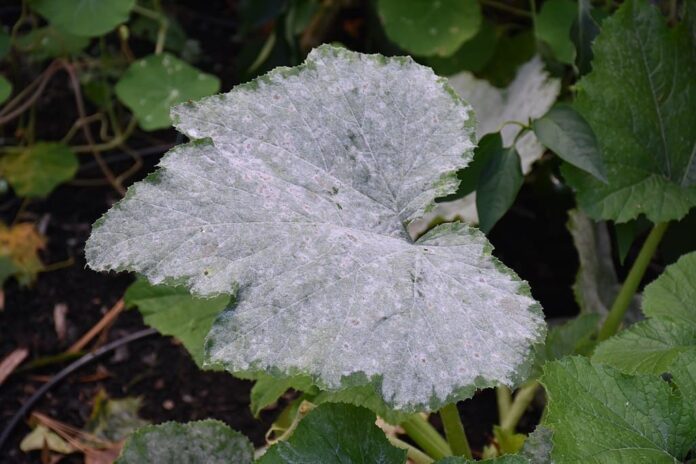
This fungal disease is a common problem that that infects a wide range of plants in gardens. There are actually many different species of powdery mildew, and each of which attacks different plants. The most common species infects gardening plants such as cucurbits, legumes, and nightshades. So from beans and cucumbers to tomatoes and more, this disease affects them all. The spores form across the top of the leaves, and they are carried by the wind from one plant to another. Chances are powdery mildew spores will come back again if you had it in your garden before.
When it occurs, it reduces both the quality and quantity of the flowers and fruit of the plants. It can slow down plant growth, and it will reduce fruit quality and yield in serious cases. While many fungal diseases prefer moist and wet conditions, this one thrives in dry and warm climates. At the same time, it tends to affect plants in shady areas more than those in direct sun. This is why you should plant your plants in spots where there is more sun to prevent powdery mildew. Don’t forget to prune overcrowded areas to increase air circulation and reduce humidity. And most importantly, water your plants from overhead to wash spores off leaves and use fungicides if you need to.
12Root Rot
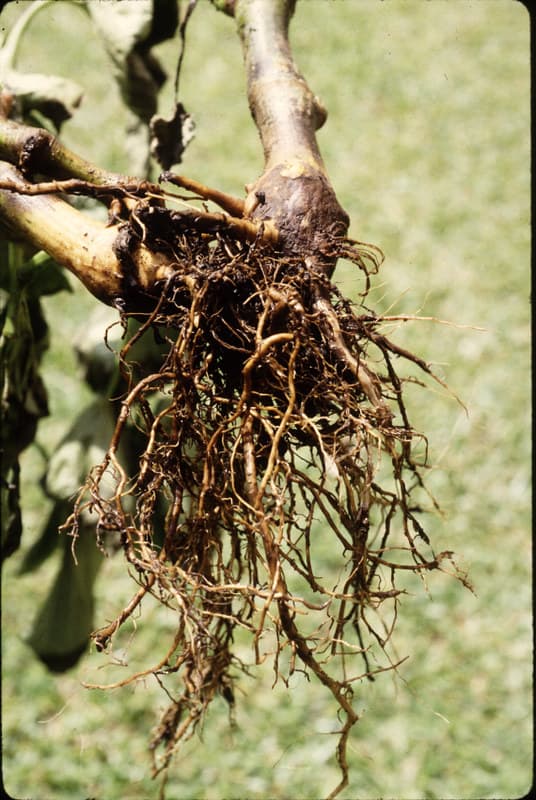
By the name, you can already tell what this infection does. Root rot is caused by fungi that thrive in wet soil that can go from one part of the garden to another. It spreads through the soil and attacks the roots of plants that grow in that wet soil. Because it infects underground, the one way to identify this disease is by looking at the plants. When the plants look like they suffer from drought and stress although you take care of them, check the roots. Plants with root rot cannot absorb moisture and nourishment from the soil properly at all; hence the mineral deficiency appearance.
Trees can also suffer from root rot, and it leads to other tree diseases such as black sap, cankers, and more. The only remedy for root rot is to remove and destroy the plant so that it won’t affect other plants. Once you identify root rot, check if you can save the plant or not. If the entire root system has already become mushy, it is too late to save it. But if you see some healthy white firm roots, replant them in fresh soil with good drainage to rescue them. To prevent the infection, do not irrigate the plant unless the soil is almost completely dry. You should keep the soil as dry as possible, and pull back the soil to allow moisture to evaporate.
13Tar Spot
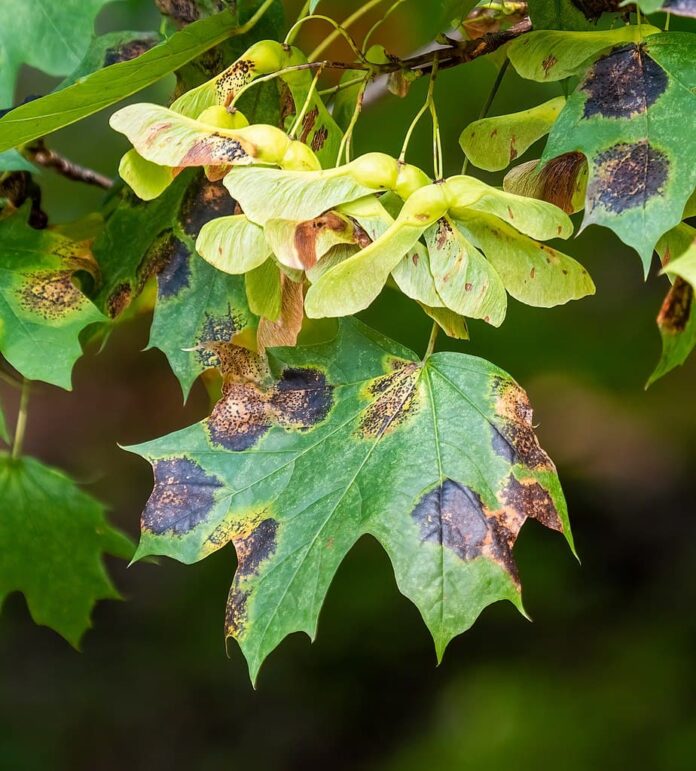
Tar spot is a common cosmetic fungal leaf spot disease that can affect many species of maple, especially in Canada. It first appears as small raised black spots that scatter across the upper and lower leave surfaces. Then the lesions turn from tan to brown with dark borders known as “fisheye” lesions. These lesions form and develop differently on different maple species, but they all blacken over time. Tar spot fungi commonly survive in leaf litter where it produces spores in the spring that lead to leaf infections. The good thing is that most maples and other susceptible trees are not vulnerable to tar spots at all. You can avoid, limit, and reduce tar spots by collecting up and properly disposing of leaves from affected trees. Make sure that the ground is clean and free from dead leaves, and you can use a fungicide to prevent it.
14Thousand Canker Disease
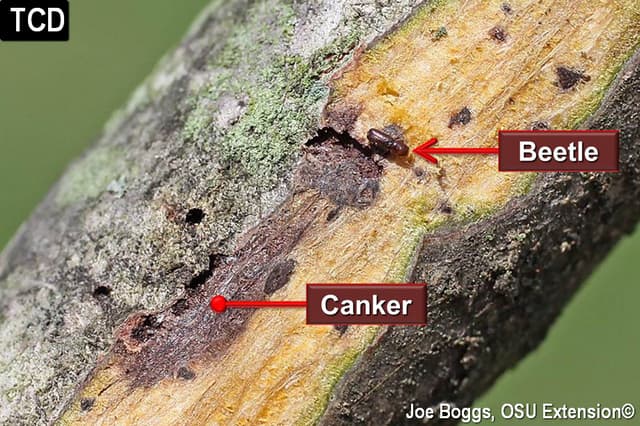
TCD is one of the most dangerous tree diseases that threaten millions of trees in forests and urban areas. Thousand canker disease is native to the western United States, and it primarily affects black walnut and butternut the most. These two are very susceptible to TCD while hickory and pecan are immune to it. It is believed that the Arizona walnut is the native host of the beetle that carries the fungus. With the combination of a fungus and walnut twig beetle, this disease can spread very fast. When occurs, the first symptoms are foliage yellowing and upper crown thinning. These two are followed by the dieback of branches and twigs before death within 3 years. There are no known effective treatments for TCD yet, but you may use chemical control if you live in the west.
Related Post: Non-Photosynthetic Plants That Don’t Need Chlorophyll

